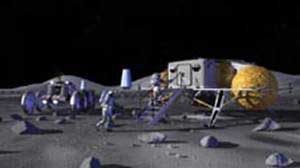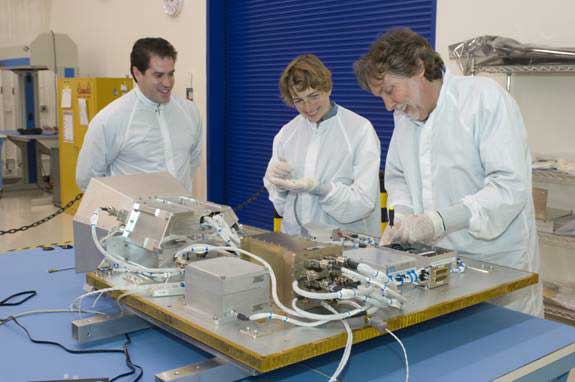Finding Water on the Moon
Superstitions and horror movies usually take center stage on Friday the 13th, but on this day in November 2009, water was the talk of the town, actually of the planet. Why?
On November 13th NASA announced an exciting development—confirmation of water on the moon. It may not sound quite as dramatic as a visit from Jason in a hockey mask, but finding water on the moon could open the door to thrilling opportunities for space exploration and have a very real affect on life on earth. How?

This is an artist's concept of a small lunar outpost. Someday, larger lunar outposts may serve as a backup for civilization in case of a global catastrophe, like an asteroid impact or a pandemic.
Credit: NASA
1. Water on the moon could make space travel more efficient
When a shuttle takes off for the moon, it contains everything that the astronauts need to complete their mission and return safely. Engineers have come up with some innovative ways to reduce and reuse things in space, such as recycling urine into drinking water. If the moon could supply water for the return trip—both for astronaut use and for creating rocket fuel, the shuttle could be lighter and have more room for other equipment.
In addition, the existence of water on the moon increases the likelihood that the moon will someday have an outpost for explorers. Human existence is largely dependent on water, and having a natural supply of it available for drinking, agriculture, fuel, and other uses made this idea much more feasible. Such an outpost would give astronauts a place to perform in-depth research, test equipment, and prepare for future missions to Mars or other objects.
Ice Core sample taken from drill.
Image courtesy National Oceanic and Atmospheric Association (NOAA)
Photo by Lonnie Thompson, Byrd Polar Research Center, Ohio State University. Cropping by Audrius Meskauskas.
2. It could reveal the story of the solar system
Much of the water on the moon is likely in the form of ice hidden deep in its shadow-covered craters, where the temperature doesn’t get above freezing. If core samples of the ice in these places could be extracted and studied, they could provide insight into the climate story of the moon and, since the moon and Earth are so intertwined, the Earth.
This technique is already being used in places like the polar caps of Antarctica. As water and snow freeze, they also freeze information about the current temperature, composition of the atmosphere, and even local events like forest fires and volcano eruptions. By studying the different layers of ice and snow from different times, scientists can reconstruct a history of the climate going back thousands and even hundreds of thousands of years.

LCROSS flight hardware in clean room at NASA Ames Research with Left to right Tony Colaprete, LCROSS Principal Investigator, Kimberly Ennico, Payload Scientist, Co-Investigator Science team. Dana Lynch, Optical Engineer on LCROSS team
Photo Credit: NASA Ames Research Center / Dominic Hart
http://www.nasa.gov/centers/ames/images/content/208362main_big_ACD07-0073-165.JPG
3. It’s really cool
As the closest object to the Earth, the moon has inspired and intrigued people from all across the world. Mayan, Hebrew, and Tibetan calendars are based on the moon. Egyptians saw lunar eclipses as bad omens. People have long associated a full moon with insanity (or “lunacy”), insomnia, accident rates, and fertility. When Galileo Galilei turned a telescope to the moon for the first time in history, most people believed that the moon was a perfect, smooth sphere.
A lot has happened in the 400 years since Galileo first saw the cratered surface of the moon. From observations with crude telescopes to observations with multi-million dollar telescopes to first-hand accounts from Neil Armstrong and the others that have walked on the moon, it may seem that there is nothing else to learn from our nearest neighbor. However, we have barely scratched the surface. Read on to find out more about what the moon can teach us.
Research
Over the last 15 years observations have hinted at the presence of water on the moon, so in order to find out for sure NASA launched the Lunar CRater Observation and Sensing Satellite (LCROSS) in September 2009. Composed of two main parts, a rocket and a guiding spacecraft, LCROSS was sent into orbit around the Earth.

Artist's rendition of Centaur upper stage rocket approaching the moon with the Lunar CRater Observation and Sensing Satellite (LCROSS), 'shepherding satellite,' attached.
Credit: NASA.
![Artist's rendering of the LCROSS spacecraft and Centaur [rocket] separation. Artist's rendering of the LCROSS spacecraft and Centaur [rocket] separation.](/explore/action/images/separation.jpg)
Artist's rendering of the LCROSS spacecraft and Centaur [rocket] separation.
Credit: NASA
![A zoom-in of the fresh Centaur [rocket] impact as seen in the LCROSS near-infrared camera. A zoom-in of the fresh Centaur [rocket] impact as seen in the LCROSS near-infrared camera.](/explore/action/images/rocket2.jpg)
A zoom-in of the fresh Centaur [rocket] impact as seen in the LCROSS near-infrared camera.
Credit: NASA
After orbiting the Earth a few times, LCROSS split in two and, at twice the speed of a bullet, the rocket crashed straight into a crater at the moon’s south pole. The blast kicked up a cloud of dust, rocks and debris from the crater floor while the guiding spacecraft took pictures. A few minutes later, the guiding spacecraft headed straight into the cloud and crashed into the moon, sending data about the debris back to Earth.
The guiding spacecraft had a lot of instruments on board for collecting data, but the primary instruments for detecting water were infrared spectrometers. When light passes through water molecules, the molecules absorb some very specific wavelengths of light in the infrared range. This changes the shape of the spectrum in a way that can only be explained by the presence of water. The data from LCROSS showed this telltale sign of water in the debris kicked up from the impact site.
Scientists are not sure exactly how much water there is on the moon, but LCROSS detected at least 25 gallons. That is a significant amount according to NASA, especially considering that the crater was only about 20 meters across.
Other data from LCROSS is still being analyzed and not much is known about the overall quantity or distribution of water on the moon. But we do know that advances in engineering, technology, and our understanding of the universe is opening many possibilities for the future—maybe even for a trip to Mars! But in order to be prepared for extreme experiences like this, we need a much better understanding of the space environment. The moon is a great training ground and just a 4-day trip away.

Hubble Ultra Deep Field Image Reveals Galaxies Galore.
Credit: NASA, ESA, S. Beckwith (STScI) and the HUDF Team
Spectrometers measure the amount of light coming from an object. They collect this data over a range of wavelengths, for example from red to blue light in the case of a visible light spectrometer.
The resulting graph has a specific shape that depends on the materials that the light had to pass through to get to the spectrometer.
Links
NASA
LCROSS Impact Data Indicates Water on Moon
Lunar Outpost Plans Taking Shape
New Scientist
Hunting for water on the moon, a brief but splashy history
*Note: Image 8 is out-of-date
Michigan State University, Chemistry Department
Infrared Spectroscopy
![The Atlas V rocket with LRO [another satellite studying the moon] and LCROSS aboard launched from Cape Canaveral Air Force Station in Florida. The Atlas V rocket with LRO [another satellite studying the moon] and LCROSS aboard launched from Cape Canaveral Air Force Station in Florida.](/explore/action/images/rocket3.jpg)
The Atlas V rocket with LRO [another satellite studying the moon] and LCROSS aboard launched from Cape Canaveral Air Force Station in Florida.
Credit: NASA/Bill Ingalls














